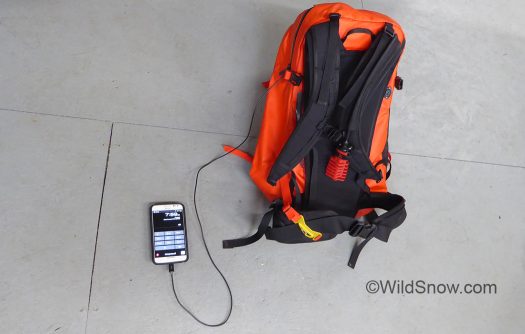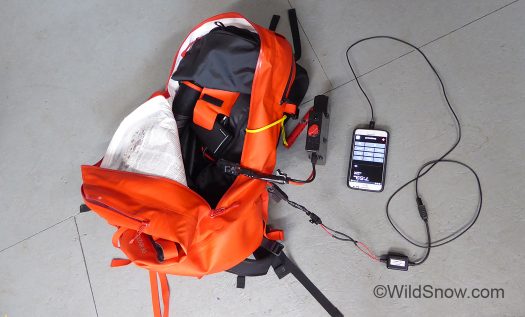If an Arc’teryx Voltair backpack has enough battery power for more than 14 balloon inflations at room temp, it clearly has enough electrons for a few hours supplying low-demand ski touring accessories (provided ambient temps are not ridiculously cold). After a little time on Amazon and help from Electrical Depot, I lashed up this wiring harness for a USB connector mod. I tested extensively and it works fine, powering my phone while the pack is armed, and not interfering with inflations. (For the curious, I could also use the battery as a stand-alone charger for the phone if I ignored the warning lights the battery displays if it’s left switched on while disconnected from the pack.)
DISCLAIMER: This is of course only a proof-of-concept. We are in no way advocating modifying your ski touring safety equipment.
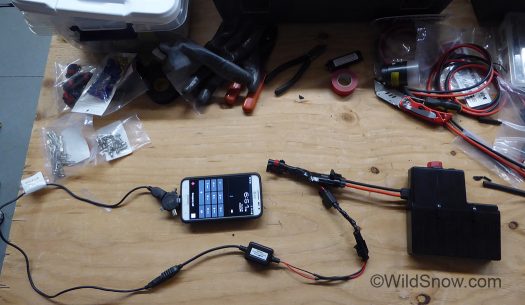
On the bench, testing. That’s the USBbuddy to left, it works with a broad range of DC voltage supply levels, in this case around 22 volts from the Voltair battery. Delphi Metri-Pack ‘jumper’ setup to right, and the Arcteryx battery.
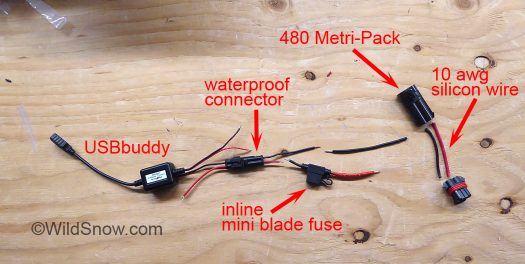
Harness parts and layout, connection to 10awg silicon wire is done by soldering the smaller wire to a ‘tap’ between the Metri-Pack connectors. Liberal use of shrink tubing and silicone ‘rescue’ tape completes the build. While the USB components are protected by the in-line blade fuse, the high amperage ‘jumper’ between the Metri-Pack connectors needs to be built ultra-reliable. I soldered everything, insulated well, then taped up with silicon tape finished with some small wire ties. Testing in freezer for behavior while stiff completed the project. If you built this for real-world use you’d pay much attention to cold temperature wire performance. You don’t want your wire insulation cracking when flexed. Igniting your backpack due to an electrical short is considered poor form in some circles — though the video would most certainly go viral.
Parts List
Following Delphi connectors from Electrical Depot
Delphi 480 12-10 Male Terminal (2 required)
Delphi 480 12-10 Female Terminal (2 required)
Delphi 480 2 Way Female Metri-Pack (housing, 1 required)
Delphi 480 2 Way Male Metri-Pack (housing, 1 required)
Delphi 480 housing seals (optional, 2)
Delphi 480 male housing snap-on wire cover (optional 1)Waterproof Electrical Connector Plug with Wire AWG Marine (low current connector, water resistant, use any type)
10 AWG Gauge Silicone Wire, red and black
Single USB connector USB voltage converter, USBbuddy is lower amperage, or use the motorcycle USB linked below as an Amazon item, it’s a 3 amp which will charge fast but probably draws too much power for efficient continous operation. The Amazon item is less weight, it’s what I ended up using.
Mini blade fuse holder and 3 amp fuse.
Assorted wiring supplies such as heat-shrink tubing, silicon tape, soldering iron and solder
Robust USB silicon or nylon braid charge cable, test in freezer for flexibility.
To do this right you need a Metri-Pack crimper. I didn’t have one so I hand-crimped the connectors and soldered them. In my opinion, even when properly crimped I’d probably give the connectors a touch with the solder. While this project is only proof-of-concept, it was useful in real life as it got me thinking about electrical safety with a battery pack this robust. Definitely, when using these electric airbag packs take care with the wires. Keep sharp metal objects far away, and inspect packing for stress on the cables. An electrical short could ignite you! Likewise, as with any LiPo battery charging I’d advise taking care with where the battery and charger are located, e.g., away from easily ignited materials and perhaps not left entirely unattended. Same precautions you should take with virtually all higher capacity rechargeable batteries, actually.
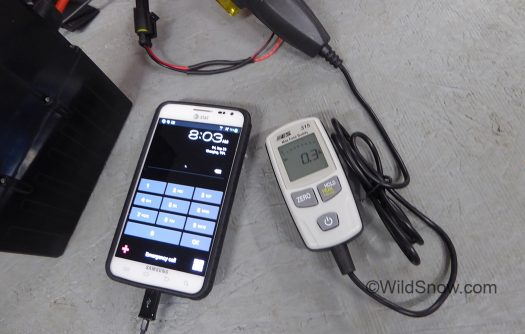
I slapped my in-line amp meter on the harness (it connects to the fuse holder, cool item), the USBbuddy draws .2 amps (photo is wrong, I had not zeroed the meter) with the phone connected and less on standby (meaning phone is turned off or disconnected but USBbuddy is operating. Correct me if I’m wrong but if the Voltair airbag backpack battery capacity is 3.7 amp hours, that means it would power my phone at .2 amps for about 18 hours? While this project is proof of concept, that that means in real life is you probably wouldn’t want to leave the USB transformer and phone constantly connected over the span of a long day of ski touring, but it would certainly power your phone for shorter days or for spot charging in the event you ran out of phone battery in the midst of a critical operation. Remember that colder temperatures will reduce the battery capacity, while on the other hand, placing a load on the battery does warm it to some extent. Also note that the motorcycle USB tap I linked to below as an Amazon item is a 3 amp “quick” charger type connection. I tested with my amp meter and it draws zero power when not connected to a device, which is nice, and still only pulled 0.3 amps when charging my iPad. Could be it’s not actually a 3 amp adapter, not a big deal, it’s light, water resistant, and said again draws no current when not connected to a device. Nice.
See our extensive Arc’teryx Voltair news coverage.
WildSnow.com publisher emeritus and founder Lou (Louis Dawson) has a 50+ years career in climbing, backcountry skiing and ski mountaineering. He was the first person in history to ski down all 54 Colorado 14,000-foot peaks, has authored numerous books about about backcountry skiing, and has skied from the summit of Denali in Alaska, North America’s highest mountain.

